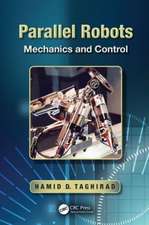Advances in Robot Kinematics
Editat de Jadran Lenarčič, M.M. Stanisicen Limba Engleză Hardback – 30 iun 2000
| Toate formatele și edițiile | Preț | Express |
|---|---|---|
| Paperback (1) | 951.77 lei 43-57 zile | |
| SPRINGER NETHERLANDS – 14 oct 2012 | 951.77 lei 43-57 zile | |
| Hardback (1) | 958.07 lei 43-57 zile | |
| SPRINGER NETHERLANDS – 30 iun 2000 | 958.07 lei 43-57 zile |
Preț: 958.07 lei
Preț vechi: 1168.38 lei
-18% Nou
Puncte Express: 1437
Preț estimativ în valută:
183.33€ • 191.89$ • 152.59£
183.33€ • 191.89$ • 152.59£
Carte tipărită la comandă
Livrare economică 31 martie-14 aprilie
Preluare comenzi: 021 569.72.76
Specificații
ISBN-13: 9780792364269
ISBN-10: 0792364260
Pagini: 442
Ilustrații: V, 442 p.
Dimensiuni: 155 x 235 x 25 mm
Greutate: 0.81 kg
Ediția:2000
Editura: SPRINGER NETHERLANDS
Colecția Springer
Locul publicării:Dordrecht, Netherlands
ISBN-10: 0792364260
Pagini: 442
Ilustrații: V, 442 p.
Dimensiuni: 155 x 235 x 25 mm
Greutate: 0.81 kg
Ediția:2000
Editura: SPRINGER NETHERLANDS
Colecția Springer
Locul publicării:Dordrecht, Netherlands
Public țintă
ResearchCuprins
1. Methods in Kinematics.- Study’s kinematic mapping — A tool for motion design.- Kinestatic analysis of serial and parallel robot manipulators using Grassmann-Cayley algebra.- Unit quaternion and CRV: Complementary non-singular representations of rigid-body orientation.- Numerically stable methods for converting rotation matrices to Euler parameters.- Geometry of homokinematic spatial Cardan shafts by dual methods.- A concise Bézier clipping technique for solving inverse kinematics problems.- Geometric calibration of robots using multiple plane constraints.- 2. Kinematic Synthesis.- On isotropic sets of points in the plane. Application to the design of robot architectures.- Fourier methods for synthesis of coupled serial chain mechanisms.- Dimensional synthesis of spatial RR robots.- Approximate motion synthesis via parametric constraint manifold fitting.- Designing linkages with symmetric motions: The spherical case.- Kinematic synthesis of planar platforms with RPR, PRR, and RRR chains.- 3. Force Analysis.- Impact analysis as a design tool for the legs of mobile robots.- Vehicle wheel-ground contact angle estimation: with application to mobile robot traction control.- The Melbourne hand.- Active force closure for multiple objects.- SCALPP: A 6-dof robot with a non-spherical wrist for surgical applications.- A framework for multi-contact multi-body dynamic simulation and haptic display.- On the dynamics of a class of parallel robots.- 4. Kinematic Redundancy.- A simplified criterion for the repeatability of redundant manipulators.- An intuitive interface for nullspace teaching of redundant robots.- Methods for resolving velocity degeneracies of joint-redundant manipulators.- Novel kinematics for continuum robots.- The optimum quality index for a spatial redundant4–8 in-parallel manipulator.- Fuzzy inverse kinematics for underwater vehicle-manipulator systems.- 5. Parallel Mechanisms and Workspace Analysis.- Symmetries in workspace densities of discretely actuated manipulators.- Workspace characterization of planar three-legged platforms with holonomic higher pairs.- Estimating the controllable workspace of tendon-based Stewart platforms.- The chord method for the determination of non-convex workspaces of planar parallel platforms.- Elasto-kinematic design tools for parallel mechanisms.- Kinematic analysis of a new parallel machine tool: the orthoglide.- Optimal trajectory planning of a 5-axis machine-tool based on a 6-axis parallel manipulator.- 6. Analysis and Application of Parallel Mechanisms.- A 4-dof parallel mechanism simulating the movement of the human sternum-clavicle-scapula complex.- Parallel mechanisms applied to the human knee passive motion simulation.- A geometric model for cylinder-cylinder impact with application to vertebrae motion simulation.- Architecture singular parallel manipulators and their self-motions.- Architectural shakiness or architectural mobility of platforms.- Möbius mechanisms.- 7. Parallel Mechanisms and Screw Algebra.- Direct kinematics of the double-triangular manipulator: An exercise in geometric thinking.- A three-dof tripod for generating spherical rotation.- Kinematical analysis and simulation of a new parallel mechanism for robotics’ application.- Early studies in screw theory.- On deriving infinitesimal twists and velocity screws from finite displacement screws.- Synthesis by screw algebra of translating in-parallel actuated mechanisms.- Author Index.






















